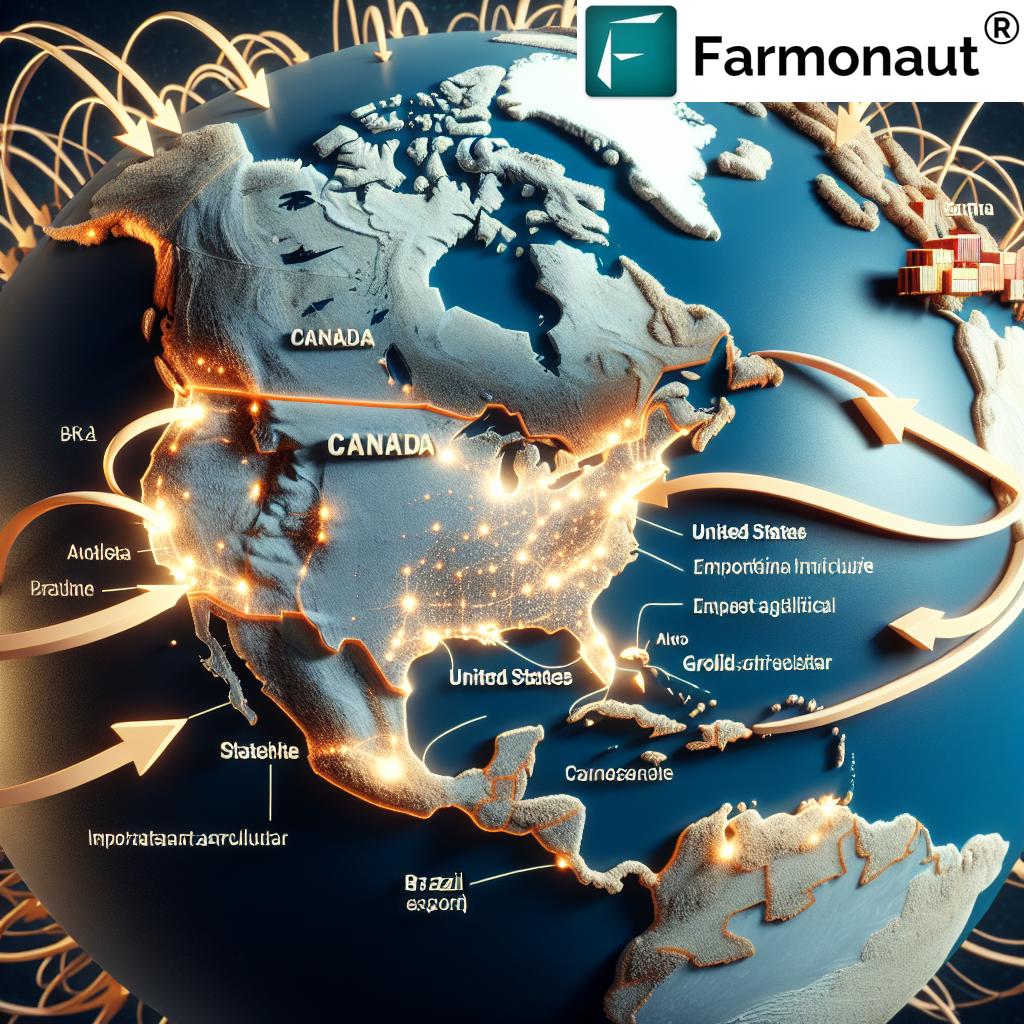Canada Potash Exports: 7 Key Global Agriculture Trends
“Canada supplies over 30% of the world’s potash, making it the largest global exporter in 2023.”
Overview of Canada’s Potash Industry
Potash, a term used for various potassium-rich salts used primarily as fertilizers, is one of the most vital raw materials in modern agriculture. As an essential ingredient for enhancing soil fertility and boosting crop yields, potash plays a crucial role in ensuring global food security.
The Canadian potash industry is centered in Saskatchewan, a province with approximately half of the world’s potash reserves. This strategic advantage positions Canada as the global leader in potash production and exports.
- Saskatchewan potash reserves comprise about 50% of global reserves.
- In 2023, Canada exported approximately 22.8 million tonnes of potash.
- Canadian exports account for over 41% of global exports.
- Top destinations: United States (46%), Brazil (19%), China (8%).
The mineral-rich province of Saskatchewan remains at the heart of the industry, with vast mines and modern operations facilitating international sales and export growth. Efficient transportation and strategic ports are integral in maintaining Canada’s dominance in the fertilizer export market.
What is Potash and Why Is It Vital for Agriculture?
Potash refers to several mined and manufactured salts that contain potassium, a nutrient essential for plant growth. In fertilizers, it contributes to stronger root development, increased drought resistance, and better nutrient uptake—directly enhancing agricultural productivity and yields.
- Potassium (K): Promotes water retention, photosynthesis, and overall plant health.
- Application: Used in fertilizer blends for cash crops and staple foods.
- Result: Higher crop productivity and more resilient food systems.
Economic Impact of Potash Exports
The potash sector is a cornerstone of the Canadian economy, especially in Saskatchewan:
- In 2022, Saskatchewan produced 24.6 million tonnes of potash, which represented 38% of global production.
- The potash industry contributes significantly to Saskatchewan’s GDP, creating thousands of jobs both directly (mining, operations) and indirectly (transportation, manufacturing, supply chains).
- This sector underpins related sectors such as logistics, manufacturing, and international trade.
The vast economic impact from potash exports supports communities, sustains regional development, and adds resilience to the Canadian economy.
Saskatchewan’s global significance is not just from raw output but from the far-reaching implications on worldwide food supply stability.
The Global Significance of Canada Potash Exports
Canada potash exports are substantial in global agriculture, acting as a bulwark for food systems in both developed and developing countries.
- Canada is the world’s largest supplier of potash, supporting productivity goals across global agriculture.
- This supports food security in the United States, Brazil, China and many other import-dependent regions.
- Exported potash strengthens Canada’s international trade position, fostering economic growth and geopolitical influence.
The potash impact on agriculture is clear: it stabilizes global food production systems and enhances the availability of essential fertilizers for critical crops.
Canada’s dominance in potash market overview aligns with changing supply and demand trends and sector resilience.
Key Players in the Canadian Potash Sector
Several major players operate within the potash export industry, driving innovation, market reach, and overall sector strength:
-
Nutrien Ltd.
- Formed by the merger of PotashCorp and Agrium in 2018
- The world’s largest potash producer
- Operates multiple mines in Saskatchewan; significant export capabilities
-
Canpotex Limited
- Founded in Saskatoon in 1972
- Largest exporting and marketing company for Canadian potash outside North America
- Manages annual sales of over 13 million tonnes
Potash Transportation in Canada: Infrastructure & Ports
Efficient potash transportation is the backbone of Canada’s dominance in the fertilizer export market. Huge volumes of potash produced in Saskatchewan need reliable logistics to reach international customers quickly and cost-effectively.
- West Coast ports (notably in British Columbia) are vital export gateways, shipping over 21,000 tonnes of potash daily to global destinations.
- Rail links connect mines to these coast ports, ensuring minimal disruptions in supply chains.
- Any transportation delays at West Coast ports can result in financial losses (e.g., up to $9.7 million in daily lost sales during a port work stoppage).
Modern logistics, strategic infrastructure planning, and adaptive responses to market disruptions secure Canada’s leadership in global potash supply.
Potash Industry Challenges & Global Supply Dynamics
The potash industry faces an array of challenges that influence market share, profitability, and global supply and demand.
1. Labor & Logistics Disruptions
-
Labor disputes at ports—such as those on the West Coast—can stop shipments, causing curtailments in export sales and lost revenue.
- November 2024: Work stoppage at West Coast ports led to a loss of up to $9.7 million per day.
- Transportation bottlenecks can strain Canada’s ability to meet global demand.
2. Geopolitical Tensions and Trade Resilience
-
Diplomatic issues, such as Canada-India tensions in 2024, highlight the potential for trade strains.
- Luckily, well-established trade relationships and a reputation for reliability have maintained Canadian potash supply continuity even through geopolitical challenges.
3. Global Competition and Market Normalization
-
Increased potash production in Russia and Belarus since 2023 has contributed to price normalization and supply chain competition.
- Canadian producers adjust output to maintain stability in global markets.
4. Evolving Supply and Demand Dynamics
- As the global population grows, potash demand is expected to increase—requiring adaptable, reliable supply chains.
- Canadian exporters must monitor and anticipate changes in agricultural market opportunities.
These potash industry challenges demand robust planning, advanced logistics, and collaborative efforts across the entire agricultural value chain.
See how blockchain-based traceability boosts supply chain trust for agricultural exports.
Sustainable Potash Practices & Future Outlook
As agriculture continues to intensify, sustainable potash practices are no longer optional—they’re imperative. Canada’s approach is a model for the world:
- Canadian potash production has under 70% of the greenhouse gas emissions per tonne compared to leading global competitors—making it one of the most sustainable options worldwide.
- Producers are investing in cleaner mining, waste management, energy efficiency, and renewable integration to further reduce environmental impact.
The future outlook for Canada potash exports is characterized by:
- Ongoing Expansion: Projects like BHP’s Jansen potash mine in Saskatchewan will add approximately 4.2 million tonnes per year to supply starting in 2026.
- Rising Global Demand: Factors like population growth and dietary shifts are expected to push global potash demand even higher.
- Strong Trade Relations: Canada’s reputation for quality and reliability helps sustain its position as a vital global supplier.
Canadian potash’s sustainable edge ensures it remains a preferred choice, especially for sustainable agricultural initiatives and food systems.
Integrate Farmonaut’s Satellite & Weather API for precision agriculture and sustainable farm management.
Access API Developer Documentation for advanced agricultural and environmental analytics.
Country-wise Comparison: Potash Exports & Key Agricultural Trends
| Country | Estimated Potash Exports (Million Tonnes, 2023) | Major Import Partners | Key Industry Challenges | Sustainable Practices Adopted |
|---|---|---|---|---|
| Canada | 22.8 | United States, Brazil, China | Port disruptions, logistics, global price pressures | Low GHG emissions, energy efficiency, waste reduction |
| Russia | ~8.0* | Brazil, China, India | Sanctions, logistics disruptions, environmental concerns | Adoption of new mining technologies |
| Belarus | ~6.5* | China, Brazil, India | Political/economic sanctions, limited export routes | Process upgrades, energy optimization |
| China | ~2.1* | India, Southeast Asia, Domestic use | High domestic demand, import reliance | Water/energy conservation in mining |
| Germany | ~2.5* | Europe, Brazil, United States | Aging mines, high operating costs | Reclamation, waste management |
*Estimated export figures
“Global potash demand is projected to reach 45 million tonnes by 2030, driven by rising food security concerns.”
Global Demand Growth: Key Drivers
- Population Increase: More people means greater food requirements and, consequently, higher demand for crop nutrients like potash.
- Changing Diets: As developing countries adopt more nutrient-dense foods (grains, fruits, vegetables, proteins), fertilizer application rises in tandem.
- Pressure on Arable Land: To prevent yield stagnation and soil degradation, continual soil nutrient replenishment is essential—driving demand for potash worldwide.
- Climate Change & Food Security: Potash use in sustainable fertilizer systems helps buffer against drought, poor soil, and climate-induced yield volatility.
How Farmonaut Supports Modern Agriculture
As global agricultural sector advances, sustainable practices and data-driven decision-making are more essential than ever. At Farmonaut, our mission is to make precision agriculture affordable and accessible to farmers worldwide.
- Satellite-Based Crop Health Monitoring – We provide real-time monitoring of crop health (NDVI), soil moisture, and fertility conditions, enabling better fertilizer application (including potash) and pest management, leading to increased yields and reduced inputs.
- AI-Driven Farm Advisory – Our Jeevn AI system delivers actionable weather forecasts, custom crop management, and soil health insights, improving decision-making and boosting agricultural productivity.
- Blockchain-Based Product Traceability – Our solutions ensure transparency and trust in food supply chains, vital for global agricultural export markets and international trade.
- Fleet and Resource Management – Farmonaut’s logistics tools optimize operations from plantation to warehouse, reducing costs and ensuring supply chain resilience.
- Carbon Footprinting – We empower agribusinesses to track and reduce environmental impact—supporting sustainable development in alignment with the world’s top potash exporters.
Explore large-scale farm management solutions designed for modern agriculture.
Secure affordable crop loans and comprehensive crop insurance using smart satellite verification.
Our platform is available as an Android/iOS/web app and via API—making cutting-edge agriculture accessible.
Frequently Asked Questions (FAQ): Canada Potash Exports and Global Agriculture
-
Q: Why is potash important for global agriculture?
A: Potash supplies essential potassium to crops, improving soil fertility, plant health, drought resistance, and yields. It is a critical component in the global drive for food security and sustainable agriculture.
-
Q: How much potash does Canada export annually?
A: In 2023, Canada exported approximately 22.8 million tonnes of potash, accounting for over 41% of the global export market.
-
Q: What are the major destinations for Canadian potash?
A: The United States (46%), Brazil (19%), and China (8%) are the primary export destinations for Canadian potash.
-
Q: How does Canada make its potash exports more sustainable?
A: Canadian potash is produced with less than 70% of the GHG emissions per tonne than that of other leading exporting countries. The industry invests in energy efficiency, waste reduction, and cleaner mining processes.
-
Q: What challenges does the Canadian potash industry face?
A: The main challenges are port labor disruptions, market competition from Russia and Belarus, transportation efficiencies, fluctuating global potash prices, and maintaining sustainable practices.
-
Q: What role does Saskatchewan play in Canadian potash exports?
A: Saskatchewan is the backbone of Canada’s potash industry, home to nearly half of global reserves and accounting for most of Canada’s production and exports.
-
Q: How can technology support the future of potash-related agriculture?
A: Satellite-based monitoring, precision farming tools, AI-driven management, and blockchain traceability ensure more efficient resource use, greater transparency, and sustainable soil fertility improvement.
Conclusion: Shaping the Future of Global Agriculture
Canada potash exports are integral to the fabric of modern agriculture and international food security. As the global population and demand for agricultural products rise, Canada’s industry is set to remain a reliable supplier, fostering economic stability, trade growth, and environmental sustainability. By addressing potash industry challenges with innovation—both in logistics infrastructure and sustainable practices—the sector demonstrates resilience that the world increasingly depends upon.
The important role of potash in enhancing soil fertility and boosting crop productivity cannot be overstated. As we move into a future shaped by climate shifts and evolving food systems, the sustainable production and strategic export of Canadian potash will continue to anchor world agriculture—enabling both food security and economic opportunity.
At Farmonaut, we’re proud to contribute to this journey by empowering farmers and agribusinesses with advanced technology, satellite analytics, and sustainable management solutions. Together, we can secure the future of global food systems—one field, one innovation at a time.














